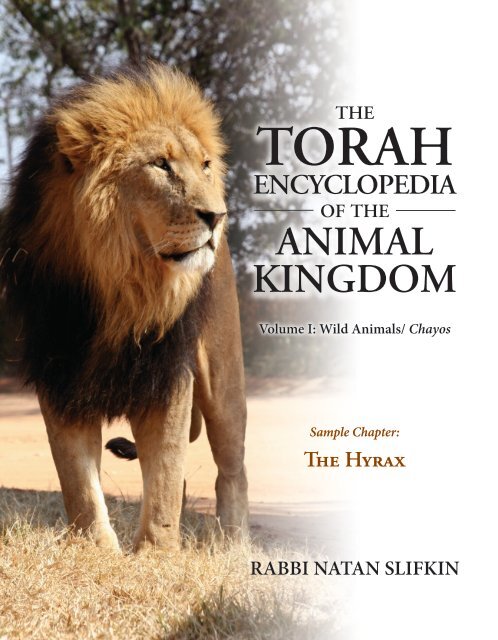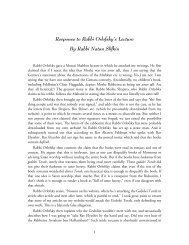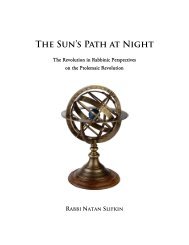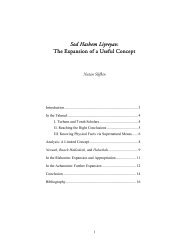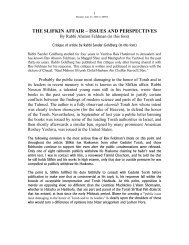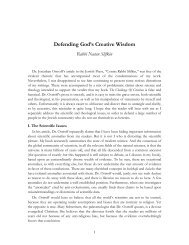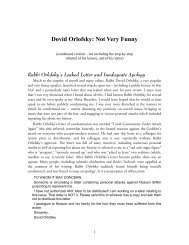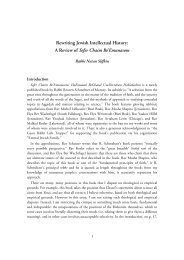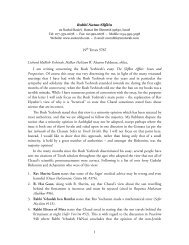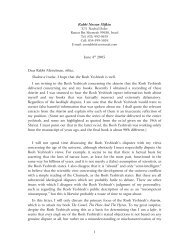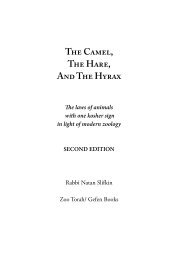You also want an ePaper? Increase the reach of your titles
YUMPU automatically turns print PDFs into web optimized ePapers that Google loves.
Hyrax
OTHER ANIMALS44ALEX KANTOROVICHA hyrax emerging from the safety of its refugeJerboas are rodents, not ruminants, and they are notknown to chew the cud. But it is possible that, like rabbitsand hares, they engage in the process known as cecotrophyor refection. This refers to their reingesting certaintypes of fecal pellets that are specifically produced for thispurpose; we shall discuss this process in more detail withregard to the hare. Many rodents practice such behavior.26 Thus, it is possible that the jerboa practices cecotrophy,and that like the hare, the jerboa would be describedas “chewing the cud” because of this.However, the jerboa cannot be the shafan. Contrary tothe beliefs of Bochart and the other European scholars—who had never seen a jerboa—no species of jerboa makesits home in rocks; all live in tunnels excavated in sand orearth. Furthermore, the <strong>Torah</strong> is only listing behemos andchayos—quadrupeds of reasonable size. Jerboas wouldpresumably be classified as sheratzim, creeping verminouscreatures, which are prohibited from consumption ina different verse. 27 Hence, the jerboa cannot be the shafan.Other writers searched further afield. Some have proposedthat the shafan is the java mouse deer. 28 This is atiny deer that occasionally hides under rocks, just as theshafan is described, and which chews the cud. It is arguedthat since the feet of the mouse deer are splayed, withhooves only covering the extremities, these are rated aspaws with claws rather than cloven hoofs. However, thisidentification is untenable for the same reasons that therabbit is untenable. The shafan is described as a familiaranimal in Scripture and Talmud, whereas the mousedeer is an obscure creature living only in the islands ofIndonesia. The description of the shafan habitually makingits home in the rocks, and mentioned in associationwith ibexes, clearly matches the hyrax far better than themouse deer. If the feet of the mouse deer are not going tobe considered as “split hooves,” then it is more reasonableto propose that we have some additional animals with asingle kosher sign than to propose that the mouse deer isthe shafan of Scripture. But in any case, the feet of mousedeer are not all that different from those of other deer;the part of the foot that touches the ground is entirelysplit, and the extremities are entirely encased by hoof.Still others suggested that the shafan is a member ofthe llama family. 29 However, such animals do not hideunder rocks. 30 Furthermore, they are only native to SouthAmerica, whereas the shafan is described in the <strong>Torah</strong>,Psalms and Proverbs, as well as in the Talmud, as a familiaranimal.The Rediscovery of the Hyrax■ IDENTIFICATIONFor Europeans, the true identity of the shafan wasfirst rediscovered in the eighteenth century by the Britishtravelers Thomas Shaw 31 and James Bruce, 32 whojourneyed throughout the Levant and reported on theplants and animals of the Holy Land. They described thehyrax in detail, for the benefit of their European readerswho did not know this creature, referring to it by itslocal names of daman Israel and ashkoko (“the bristlyone”). They noted that it is clearly the shafan described inScripture: a smallish animal that hides in the rocks and isobserved to chew its cud. Furthermore, the fact that thehyrax lives together with ibex in the same habitat meansthat it is clearly being described in the verse, “The highhills are for the ibex, the rocks are a refuge for the shefanim.”In the nineteenth century, many more first-handstudies were made of the wildlife of the Land of Israel,further spreading the awareness that the hyrax is the shafan.Thus, Rabbi Yosef Schwartz, who wrote a book onthe geography and natural history of the Land of Israelbased on his experiences there, identified the shafan asthe hyrax, giving it the Arabic name of wabr (like RavSaadiah Gaon). 33It took a while for knowledge of the hyrax to spreadthrough Europe; in the nineteenth century, while someaccepted that it is the shafan, 34 others remained unfamiliarwith the hyrax and maintained that the shafan waseither the rabbit or jerboa, working with the mistakenbelief that these animals habitually hide in rocks. Eventually,however, as knowledge regarding all these animalsincreased, it became clear that the rabbit and jerboacould not be the shafan, while the hyrax was an excellentmatch. Thus, in the nineteenth century, Rabbi Meir Leibush(known as Malbim) and Rabbi Dovid Tzvi Hoffmanboth explained that the shafan is the hyrax. 35By the twentieth century, the hyrax was already becomingwell-known (and terms for it such as coney and rock-
adger became antiquated). All scholars of Scripturalzoology accepted it as the shafan. 36 The only people toreject identifying the shafan as the hyrax are those whoare uncomfortable with the Scriptural description of it“chewing the cud,” due to their particular religious outlook(as we shall explain), or those who are uncomfortablewith stating that the great <strong>Torah</strong> scholars of medievalEurope were only familiar with animals from their part ofthe world. However, no other remotely viable candidatefor the shafan exists. 37Does the Hyrax Chew The Cud?■THEOLOGY, PHILOSOPHY AND SCIENCEThe <strong>Torah</strong> describes the shafan as ma’aleh gerah, literally“bringing up by way of the throat,” 38 but more simplytranslated as “chewing its cud.” Although hyraxes possessunusual digestive systems, there is no chamber producing“cud” to be chewed.Yet there have been certain observers who claim to haveseen the hyrax chewing its cud. The eighteenth-centurytraveler Bruce, who rediscovered the hyrax for Europe,kept a captive hyrax specifically in order to examine this,and writes that it does indeed ruminate. In the twentiethcentury, one zoologist likewise reported having seenhyraxes chewing their cud, albeit for a much shorterperiod than with regular ruminants. 39Nevertheless, the consensus of zoologists is that thehyrax does not ruminate. Animals that ruminate areclearly observed to do so, engaging in this behavior forlong periods of time. Studying hyraxes does not revealsuch behavior.But there is another possibility. There is a very limitedform of rumination, called “merycism,” which is foundin some Australian marsupials such as koalas and kangaroos,and in other animals such as proboscis monkeys.With merycism, the animal regurgitates a small amountof food, and it is not chewed as thoroughly as is the casewith ruminants, nor does it play as fundamental a rolein digestion. Still, this would undoubtedly be sufficientbasis for the <strong>Torah</strong> to describe such a process as “bringingup the cud.” Hyraxes frequently make brief chewingmovements with their mouths, long after they have eaten.There also appears to be movement in the throat immediatelypreceding these chewing motions. 40 Perhaps thehyrax engages in merycism, which would account forthose who have claimed to observe it ruminating, as wellas the <strong>Torah</strong>’s description of it.HYRAXA hyrax demonstratingits ruminant-like methodof chewingWEIZIANG NG45
OTHER ANIMALS46GORDON CONGDONHowever, other zoologists doubt this interpretationof the actions of the hyrax. They argue that hyraxes willwork their jaws from side-to-side when confronted withsomething new and potentially dangerous, as a threateninggesture. It is therefore suggested that all allegedobservations of the hyrax chewing its cud may in fact beobservations of a form of communication that has nothingto do with food. 41Those who conclude that the hyrax does not chew itscud are therefore faced with the question of why the<strong>Torah</strong> describes it as a ruminant. One approach to thisrelates to the hyrax’s internal physiology. The hyraxpossesses a somewhat ruminant-like gut, with threedistinct areas for digestion. 42 This in turn means thathyraxes take a long time to digest food, and are ableto process fiber efficiently, similar to a ruminant. 43According to some zoologists and rabbinic authorities,this internal digestive physiology is the basis for the<strong>Torah</strong> idiomatically describing the hyrax as chewingthe cud. 44Another approach is based on the fact that the lateral,gyratory chewing move ments of the hyrax’s jaws,resemble those of a cud-chewer. 45 Furthermore, likeruminants, hyraxes engage in chewing actions evenwhen they are not grazing. Superficially, then, a hyraxcertainly looks as though it is ruminating, and someexplain that the <strong>Torah</strong> therefore describes it as bringingup the cud. 46There are several ways of explaining the precise reasoningbehind this. One explanation is that these chewingmotions cause people to mistakenly think that the hyraxbrings up the cud, which is why the <strong>Torah</strong> had to mentionit. Another explanation is that since most animalsthat chew in this way are cud-chewers, the term “chewingthe cud” is used idiomatically to refer to all animals thatchew in such a way.Alternately, and perhaps preferably, usage can be madeof the principle that dibra <strong>Torah</strong> k’lashon bnei adam,“the <strong>Torah</strong> speaks like the language of men.” This phraseappears in numerous places throughout the Talmud andMidrash, in the rabbinic works of the medieval period,and in the writings of recent scholars, and its meaningvaries. 47 But according to several important rabbinicauthorities, it means that the <strong>Torah</strong> packages its messagesand laws within the scientific worldview of antiquity.48 Thus, since the hyrax appears to chew the cud andis commonly thought of as being a cud-chewer, the <strong>Torah</strong>describes it as such.
N. SLIFKINHYRAXThe Only Such Animals in the World?■THEOLOGY, PHILOSOPHY AND SCIENCEThe Talmud states that the four animals listed in the<strong>Torah</strong> as possessing only one of the two kosher signs arethe only such animals in the world:…The school of Rabbi Yishmael taught: “And the camel,because it (hu) brings up the cud etc.”—the Ruler of Hisworld knows that there is no creature that brings up thecud and is non-kosher except for the camel (and theother animals listed), therefore Scripture specified it withhu (“it” i.e. these animals alone chew the cud but lacksplit hooves). (Talmud, Chullin 59a)Yet, based on the previous discussion, there is a difficultywith this statement. In order to account for why thehyrax is described as bringing up its cud, we noted thatthe definition of bringing up the cud has to be expandedto include merycism, a compartmentalized stomach, orruminant-like chewing. In the section on the hare, wewill see that it was also extended by some to include aphenomenon known as cecotrophy. All these featuresalso exist with other animals—kangaroos engage inruminant-like chewing, koalas and proboscis monkeysengage in merycism, capybaras engage in cecotrophy,and many animals have compartmentalized stomachs.Accordingly, there are more than just four animals withone kosher sign. This would appear to contradict thestatement of the school of Rabbi Yishmael that the fouranimals in the <strong>Torah</strong>’s list are the only such animals inthe world.One solution to this problem is that the word “world”can have different meanings. The word “world” of theSages presumably does not include other planets. It alsoneed not refer to the entire planet Earth. There are severalinstances in the Talmud where we see that it refers to alimited region, such as the civilized areas of the worldfamiliar to the Sages. 49 Accordingly, since these otheranimals with one kosher sign live in remote regions suchas South American and Australia, they do not conflictwith the Talmud’s statement. In the world of the <strong>Torah</strong>,the four animals listed as possessing one kosher sign areindeed the only such animals.Elsewhere, the Talmud states that Moses’ statementsabout the laws of kosher animals are evidence for thedivine origins of the <strong>Torah</strong>. 50 The precise reference andmeaning of the Talmud’s statement is unclear and disputed.51 But, apparently beginning in the eighteenth cen-47
OTHER ANIMALS48tury, it was taken as referring to the list of four animalswith one kosher sign, and as meaning that these are theonly such animals on the planet, in line with the aforementionedexegesis. 52 However, in light of the fact thatthe list of four animals is best understood as referringto animals from the local region rather than being anexclusive list of all such animals on the planet, this recentinterpretation of the argument for the divine origins ofthe <strong>Torah</strong> is problematic.The Median Hyrax■ SYMBOLISMThe Sages explained the four kingdoms under whichthe Jewish People were exiled – Babylon, Persia-Media,Greece, and Rome – as being a motif that is expressedin many different forms in Scripture. They thereby perceivedthe turbulent events of history as being part of thegrand Divine plan for creation. 53Elsewhere, we have seen that the four wild beasts inDaniel’s vision symbolized these four kingdoms. Buteven concepts in the <strong>Torah</strong> that are not obviously symbolicwere also interpreted as referring to the same motif.Thus, the <strong>Torah</strong>’s list of animals with one kosher sign—thecamel, hyrax, hare and pig—was interpreted by the Sagesas referring to the four kingdoms. Unlike the symbolismof the predators in Daniel’s dream, which is wholly negative,these animals possess one of the two signs requiredfor an animal to be kosher, and as such they express a certainpositive symbolism. The hyrax, second in the list, isunderstood to allude to the second of the four kingdoms:the joint kingdom of Persia and Media:Rabbi Shmuel bar Nachman said: The prophets all sawthe kingdoms going about their business. Moses sawthe kingdoms going about their business: “The camel” isBabylon… “the hyrax” is Media. The rabbis and RabbiYehudah son of Rabbi Simon [differed regarding this].The rabbis said: Just as this hyrax has a kosher sign (i.e.bringing up the cud) and a non-kosher sign (i.e. no splithooves), so too the kingdom of Media established both arighteous person (i.e. Darius II) and an evil person (i.e.Ahasuerus). 54 Rabbi Yehuda son of Rabbi Simon said:Darius II, son of Esther, was pure from his mother’s sideand impure from his father’s side… (i.e. the kosher andnon-kosher aspects are expressed in the same person).(Midrash Vayikra Rabbah 13:5)The Midrash continues with further parallels, based onplays-upon-words in the description of the hyrax bringingup its cud:Another explanation: …“the hyrax” is Media, “for itraises up the cud” – that it [raised its voice in] praise ofthe Holy One, as it says, “So says Cyrus, king of Persia”(Ezra 1:2)…Another explanation: … “the hyrax” is Media, “for itbrings up its cud” – that it ‘brought up’ Mordecai, as itsays, “And Mordecai sat at the gate of the king” (Esther2:21)….Another explanation: … “the hyrax” is Media, “for itbrings up the cud (gerah)” – that it dragged (megarer)another kingdom after it (i.e. Greece). (Midrash VayikraRabbah ibid.)Similar such parallels were drawn in other Midrashictexts. 55 Later scholars sought to find further groundsfor the hyrax to symbolize Persia/Media. It waspointed out that one of the major cities of the Medianempire was Isfahan, which is etymologically similar toshafan. 56Perhaps most remarkable is how a passage in Proverbsdescribing four small yet ingenious animals – the ant,hyrax, locust, and spider – was likewise interpreted bythe Sages as referring to the four kingdoms. Here, too, thehyrax symbolizes Persia and Media, and a further parallelis added to the metaphor:“There are four in the land that are small” (Prov. 30:26)– This alludes to the four kingdoms…. “The hyraxes arenot a strong people” — this refers to Media. Just as thehyrax has a kosher sign and a non-kosher sign, so tooMedia; Ahaseurus the uncircumcised, and Esther theJew. “And they put their homes amongst the rocks” —that they sought to build the Holy Temple, as it says, “Sosays Cyrus king of Persia…” (Midrash Mishlei 30:26; YalkutShimoni, Mishlei 904)The hyrax’s homebuilding could have been comparedto the Persian building of palaces. Instead, it was interpretedas symbolizing the Persian rebuilding of the Temple.This denotes an unusually positive view of both thePersian-Median empire as well as the non-kosher hyrax.It seems that, notwithstanding its non-kosher statusand subsequent symbolism for a foreign empire, thehyrax was always perceived in a positive light. The referencesto the hyrax in Psalms and Proverbs present it aspart of the beauty and wonder of the natural world. Wealso find that the scribe who served as emissary of therighteous king Yoshiyahu was named Shafan, indicatingthat the hyrax had positive associations. 57 It seems thatthere was always a fondness for this familiar, yet somewhatenigmatic, small furry animal. ■NOTES1 Note that the term “coney,” which is used in some works as a translationof shafan (or arneves), usually refers to the rabbit, and was originally used byEuropean and American translators who were unfamiliar with the hyrax.Since then, the word has sometimes also been used to refer to the hyrax.2 For more extensive discussion, see The Camel, The Hare And The Hyrax( Jerusalem: <strong>Zoo</strong> <strong>Torah</strong>/ Gefen Books 2011), by this author, as well asvarious posts at www.rationalistjudaism.com.
Perhaps hyraxes were regarded favorably because theyare simply cute, especially babies such as this one3 J. B. Sale, “The habitat of the rock hyrax,” Journal of the East AfricanNatural History Society (1966) 25 pp. 205-214.4 Arik Kershenbaum, “Rock hyrax (Procavia capensis) den site selection:preference for artificial sites,” Wildlife Research (2011) 38 pp. 244–248.5 H. Hoeck, “Hyraxes,” in The Encyclopedia of Mammals (Ed. D.MacDonald, Oxfordshire: Andromeda Oxford 2001).6 V. Gargett, The Black Eagle: A Study (Randburg, South Africa: AcornBooks, 1990).7 Ibn Ezra, Commentary to Leviticus 11:13.8 Fulgence Fresnel, Journal Asiatique, 3rd series, v. 514, cited in The JewishEncyclopedia (New York and London: Funk & Wagnalls Company 1901),“Coney.”9 H.B. Tristram, The Natural History of the Bible (New Jersey: GorgiasPress 2002, reprint of 1883 ed.), p. 75.10 See the commentaries of Chizkuni, Bechor Shor and Rabbi ChaimDov Rabinowitz, Da’as Sofrim ( Jerusalem 1986) to Leviticus 11:4.11 H. B. Tristram, The Natural History of the Bible, p. 77.12 Talmud, Chullin 59a.13 K. Rübsamen, I.D. Hume and W.V. Engelhardt, “Physiology of theRock Hyrax,” Comparative Biochemistry and Physiology A (1982) 72:2 pp.271-277. Rabbi Dovid Tzvi Hoffmann notes that the word tafza couldwell refer to the hyrax for this reason.14 See Ilya Dines, “The Textual and Pictorial Metamorphoses of theAnimal called Chyrogrillius,” in Science Translated: Latin and VernacularTranslations of Scientific Treatises in Medieval Europe, eds. Michèle Goyens,Pieter De Leemans and An Smets (Mediaevalia Lovaniensia, Series I, StudiaXL), (Leuven: Leuven University Press, 2008), pp. 73-90.15 This was the etymology given by Heyschius of Alexandria in his fifthcenturydictionary; see H.G. Liddell, A Greek-English Lexicon (Oxford,1897), p. 1732.16 Julius Fuerst, A Hebrew & Chaldean Lexicon to the Old Testament (London:Willams & Norgate 1867, translation by Samuel Davidson) p. 1432.17 Rosenmüller, Handbuch der Biblischen Alterthumskunde (Leipzig:Baumgärtner 1823-1831) vol 4 part II p. p. 220, likewise states that thehyrax earns its Amharic name of aschkoko due to its possessing hedgehoglikehairs that resemble thorns, called aschok in Amharic.18 Although Hieronymus used this translation for shafan in Leviticusand Deuteronomy, he used ericii (hedgehog) for the shafan in Psalms,and lepusculus (small hare) for the shafan in Proverbs; presumably, hedecided to use terms that would be more familiar to his readers. See IlyaDines, “The Textual and Pictorial Metamorphoses of the Animal calledChyrogrillius,” loc cit.19 Letter to Sunnias and Fretela (403 CE). Cited by Rosenmüller andRabbi Dovid Tzvi Hoffman.20 H. B. Tristram, The Natural History of the Bible (New Jersey: GorgiasPress 2002, reprint of 1883 ed.), p. 75.21 “…The cape hare (Lepus capensis)… is the only endemic species oflagomorph known from theMiddle East since the Middle Pleistocene” - Eitan Tchernov, TheodoraBar-El, “Lagomorph Remains at Prehistoric Sites in Israel and SouthernSinai,” Paléorient (2000) 26:1 pp. 93-109. One can find occasionalreferences to rabbits in Israel, but closer investigation inevitablydemonstrates these to be mistakes, and to actually be describing hares.22 Yosef Schonhak, Toldos Ha-Aretz (Warsaw: H. Bomberg 1841) vol.I p. 32, rejects identifying the shafan as the rabbit for this reason, as doesKisvei HaRav Dr. Yosef HaLevi Zeliger ( Jerusalem: Defus Ivri 1930) p.236, also cited in Teshuvos R’ Yitzchak HaLevi Herzog, Yoreh De’ah 23.23 Samuel Bochart, Hierozoïcon Sive Bipertitum Opus De AnimalibusSacre Scripturae (“A Natural History of Old: A Two Volume Work onAnimals of the Sacred Scriptures”) (London 1663), vol. 1 pp. 1001-1017.24 The Copto-Arabic lexicon by Barakat Ibn Kabar was called the ScalaMagna; in the seventeenth-century, Athanasius Kircher made the workavailable to the West in his trilingual Lingua Aegyptiaca Restituta. Thechyrogrillius is translated into Arabic on p. 165.25 Rabbi Dr. Ludwig Lewysohn, Die <strong>Zoo</strong>logie des Talmuds (Frankfurtam Main 1858), p. 110 (strangely, although he refers to Rosenmüller inhis Handbuch der Biblischen Alterthum skunde—who rejected the jerboain favor of the newly-rediscovered hyrax—Lewysohn makes no mentionof the hyrax and misunderstands the term klipdachs as referring to thejerboa). Alexander Kohut (1842-1894), in his extended commentary onthe Aruch entitled Aruch HaShalem, identifies the shafan as the Dipusjaculus, which is a species of jerboa. Yosef Schonhak, Toldos Ha-Aretz(Warsaw: H. Bomberg 1841) vol. I (Toldos HaChaim), ma’areches hayonkim,p. 32, observes that the jerboa described by these authors livesin tunnels in the sand, and thus cannot be the shafan, which is describedin Psalms and Proverbs as dwelling in the rocks. Schonhak identifies itinstead as the alkadaga (which today, in the form of Allactaga, refers toa particular genus of jerboas), claiming that this species of jerboa doesindeed make its home in the rocks. However, this is not in fact the case.26 D. M. Stoddart, “Rodents: Equipped for Gnawing,” The Encyclopediaof Mammals (Ed. D. MacDonald, Oxfordshire: Andromeda Oxford2001), p. 58027 Leviticus 11:41. The hyrax is a significantly larger creature than thejerboa and is therefore defined as a chayah, albeit barely. Note that inProverbs, the shafan is grouped with the locust, ant and spider as beingone of the small creatures.28 Rabbi Yaakov Yechezkel HaLevi (1814–1864), Bikkores HaTalmud(Vienna, 1863), pp. 387-9; he also proposes that the arneves is thegreater mouse deer. A similar suggestion is proposed by Tzvi Weinberger,“Identifying the Biblical Arneveth with the Musk-Deer and the Shafanwith the Mouse-Deer: A Hypothesis” (Hebrew), BDD 27 (March 2013).29 Rabbi Meyer Lubin, “Identification of the Gamal, Shafan and Arnevet,”in Intercom magazine, May 1973; Rabbi Dr. Moshe Tendler, “<strong>Torah</strong> andScience: Constraints and Methodology,” in The <strong>Torah</strong> U-Madda Journal,Volume 5, 1994, p. 178.30 Rabbi Dr. Yosef Zeliger, Kisvei HaRav Dr. Yosef HaLevi Zeliger( Jerusalem: Defus Ivri 1930) pp. 236-237 suggests that the shafan andHYRAX49
OTHER ANIMALS50arneves are two undiscovered miniature varieties of camel, one even smallenough to hide under rocks, but the conspicuous absence of any fossilsor other evidence for such extraordinary creatures renders this highlyimplausible.31 Thomas Shaw, Travels, or, Observations Relating to Several Parts ofBarbary and the Levant (1738) p. 376.32 James Bruce, Travels to Discover the Source of the Nile, Vol. VI: SelectSpecimens of Natural History (1790) pp. 179ff.33 Rabbi Yosef Schwartz, Tevuos Ha-Aretz ( Jerusalem 1845).34 See e.g. Ernst Friedrich Rosenmüller, Handbuch der BiblischenAlterthumskunde vol 4 part II pp. 213-222; David Scot, “On the Saphan ofthe Hebrew Scriptures,” Memoirs of the Wernian Natural History Society,vol. 6 (1832), pp. 103-112.35 Commentaries to Leviticus 11:5.36 E.g. Shimon Bodenheimer, HaChai B’Eretz Yisrael (Tel Aviv: Dvir1953) p. 245; Menachem Dor, HaChai BiMai HaMikra HaMishnahVeHaTalmud (Tel-Aviv: Grafor-Daftal books 1997), p. 56; YehudahFeliks, The Animal World of the Bible (Tel-Aviv: Sinai 1962) p. 45.37 The notion that the shafan is an unknown or extinct animal can berefuted on zoological and zooarcheological grounds. Chapter five of TheCamel, The Hare And The Hyrax is dedicated to this.38 Following Ibn Ezra, Chizkuni, Radak, Rashbam, and contemporarylinguistic scholarship.39 Hubert Hendrichs, “Vergleichende Untersuchung des wiederkauverhaltens”[Comparative investigation of cud-chewers], BiologischesZentralblatt (1965) 84:6 pp. 736-739 (German).40 This author has filmed such behavior in his own captive hyrax, whichcan be viewed online at www.zootorah.com.41 J. B. Sale, “Daily food consumption and mode of ingestion in thehyrax,” Journal of the East African Natural History Society (1966) 25 pp.215-224; Mendelssohn and Yom Tov, Fauna Palaestina: Mammalia ofIsrael, p. 236.42 E. T. Clemens, “Sites of organic acid production and patterns ofdigesta movement in the gastrointestinal tract of the rock hyrax,” Journalof Nutrition (1977) 107:11 pp. 1954-61.43 J. R. Paul-Murphy, C. J. Murphy et al., “Comparison of transit time ofdigesta and digestive efficiency of the rock hyrax, the Barbados sheep andthe domestic rabbit,” Comparative Biochemistry and Physiology A (1982)72:3 pp. 611-613.44 Yehudah Feliks, The Animal World of the Bible (Tel-Aviv: Sinai, 1962),p. 45, cited approvingly by Rabbi Menachem Kasher, <strong>Torah</strong> Sheleimah,Vayikra 11:31.45 The skull of a hyrax and its musculature is actually very similar to thatof ruminants, due to the shared need to extensively masticate the food.See C. M. Janis, “Muscles of the masticatory apparatus in two genera ofhyraces (Procavia and Heterohyrax),” Journal of Morphology (1983) 176pp. 61-87.46 Rabbi Dovid Tzvi Hoffman, Commentary to Leviticus 11:5, p.228, in reference to the hare/arneves but also applicable to the hyrax;also cited by Rabbi Yechiel Yaakov Weinberg, Seridei Aish (vol. II, 17);Rabbi Menachem Kasher, <strong>Torah</strong> Sheleimah to Leviticus 11:32; and RabbiAmitai Ben-David, Sichas Chullin to Chullin 59a. An early reference tothis is in H. B. Tristram, The Natural History of the Bible (New Jersey:Gorgias Press 2002, reprint of 1883 ed.) p. 76.47 See Zion Ukshi, “The <strong>Torah</strong> Speaks Like the Language of Men—TheDevelopment of the Expression and its Nature” (Hebrew), Derech Efrata9-10 (5761) pp. 39-59.48 See Rambam, Guide for the Perplexed 2:8 and 3:3, with thecommentaries of Efodi, Shem Tov, Narvoni, and Abarbanel in Ta’anos,4, and Rabbi Shlomo Fisher, Derashos Beis Yishai, Ma’amar Hamo’achVehalev, fn. 4; Ralbag, commentary to Gen. 15:4, and commentary toJob, end of ch. 39; Rabbi Dr. Isadore Twersky, “Joseph ibn Kaspi: Portraitof a Medieval Jewish Intellectual,” Studies in Medieval Jewish Historyand Literature, volume 1 (Harvard University Press, 1979), pp. 239-242; Rabbi Samson Raphael Hirsch, Collected Writings vol. 7 p. 57 andcommentary to Genesis 1:6; and Rabbi Avraham Yitzchak Kook, AdarHaYekar, pp. 37-38.49 Rabbi David Gans, a disciple of the Maharal of Prague, in NechmadVe’Na’im 89, notes that the word olam sometimes refers to the entireuniverse, sometimes to planet Earth, and sometimes to a limited region,such as with the Talmud’s references to warfare coming to the olam (Sukkah29a). Rabbi Gans uses this to explain the statement that “Jerusalem is inthe center of the world”—he explains that it refers to the areas inhabited inBiblical and Talmudic times. Rabbi Gedalyah Nadel, one of the foremostdisciples of the Chazon Ish, in B’Toraso Shel R’ Gedalyah (Maale Adumim:Shilat 2004), p. 118, brings further evidence for the “world” of the <strong>Torah</strong>being of limited scope, in the context of explaining that the Deluge waslimited to Biblical lands. The Talmud rules that someone who makes anoath to abstain from drinking the waters of the Euphrates is “prohibitedfrom all the waters in the world.” Now, while there are many tributaries ofthe Euphrates, there is certainly no chance that, say, a stream in Americais connected to the Euphrates! Hence, concludes Rabbi Nadel, when theTalmud speaks about the “world,” it refers to the world of the Sages. Inpersonal discussion with the author, Rabbi Nadel suggested applying thisapproach to the Talmud’s statement regarding the four animals.50 “But was Moses a hunter or trapper? From here there is a refutation ofone who says that <strong>Torah</strong> is not from Heaven” - Talmud, Chullin 60b.51 Tosafos to Chullin 60b explain the argument as referring to theknowledge of the shesuah, a mutant animal that the Talmud infers asbeing mentioned in Deuteronomy. Rashi to Chullin 60b, and Netziv inhis commentary to Sifri, Re’ay 49, understand the argument as referring tothe detailed information presented about all the different animals in the<strong>Torah</strong>’s laws of kashrus.52 Naftali Hertz Wessely, Levanon, Gan Na’ul, HaBayis HaRishon, Cheder7, Chalon 7; Maharatz Chayes, Commentary to Chullin 60b; Malbim toLeviticus 11:6; Rabbi Pesachyah Menken in Kerem Pesachyah ( Jerusalem1931) p.118, citing Wessely; Rabbi Baruch HaLevi Epstein (1860-1942)in <strong>Torah</strong> Temimah (1902) Leviticus 11:4 note 17.53 Rivka Raviv, “The Talmudic Formulation of the Prophecies of the FourKingdoms in the Book of Daniel” (Hebrew), Jewish Studies, an InternetJournal (2006) pp. 1–20.54 This follows the interpretations of Yefeh Toar. According to MatnosKehunah, it refers to Mordecai and Haman.55 Midrash Tanchuma, Shemini 8, presents further parallels between thefour animals with one kosher sign and the four kingdoms. The printedאת השפן זו יון שהשפילה את התורה Greece: version has the hyrax representingמפי הנביאים שנאמר )יחזקאל יד( הנה ימים באים נאם ה’ והשלחתי רעב וגו’ וכתיב ונעו מים עד10:3, 1870) R. Shmuel Waldberg, Darchei HaShinuyim (Lemberg .’ים וגושהשפילה את התורה מפי הנביאים acronym: p. 66b says that this is based on anHowever, R. Meir ben Samuel Benveniste, in Os Emes (Salonica 1565) (p.48a in Prague 1624 edition) emends the text in order to make the hyraxאת Midrashim: represent Media, thus bringing it into line with the other. This would ’השפן זו מדי שעשתה את ישראל פאה והפקר להשמיד להרוג ולאבד את כל וגוappear to be correct, since the other verse is followed by a statement thatthe mother of Ptolemy was named after a hare, indicating that that sectionis speaking about Greece rather than Media.56 Avraham Epstein, MiKadmoniyus HaYehudim (Vienna 1887), vol. 1,pp. 31-35.57 II Kings chapter 22.


